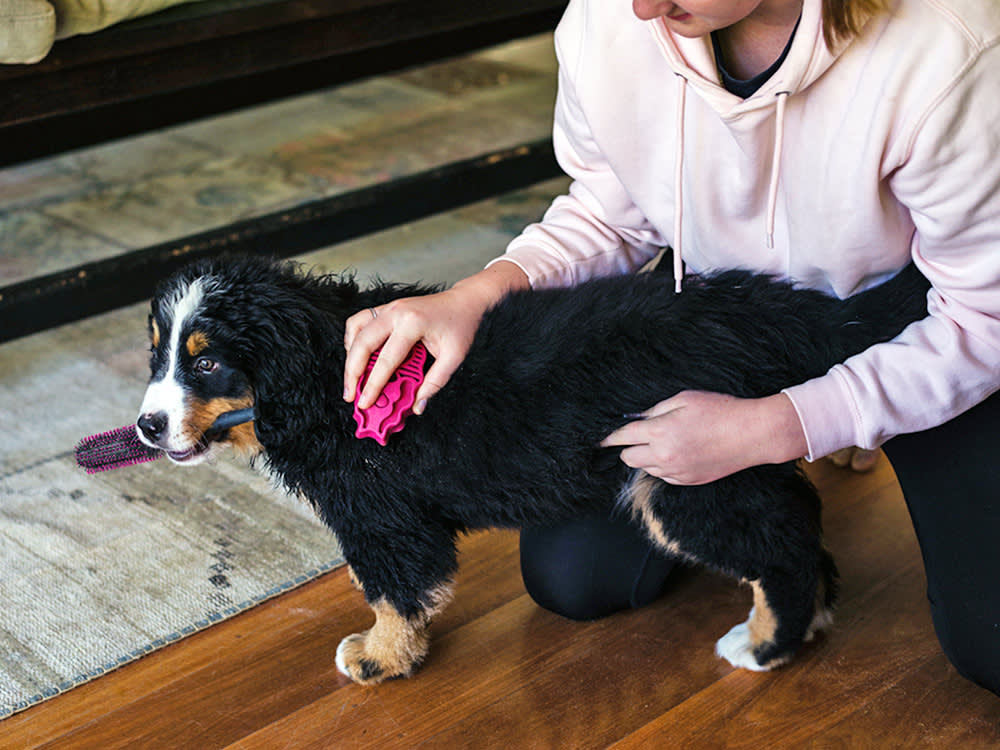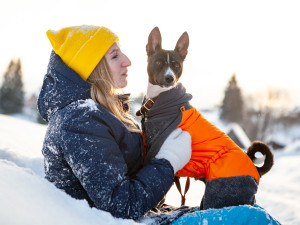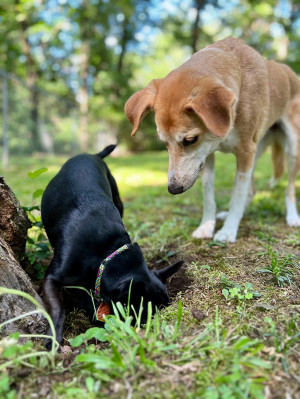How to Identify Fleas on Dogs and Humans
No one wants to find them, but here’s what to look out for.

Share Article
In This Article:
What Do Flea Bites Look Like? What Do Flea Bites Look Like on Dogs? Dog Flea Bites on Humans: Tips for Identifying Flea Bites When to Consult a Vet or Doctor Frequently Asked Questions
Fleas are the worst. Or at least one of the most annoying things that we deal with as pet parents. They drive our pets wild with itchiness, set up their extended families in our homes, and are a real nuisance to get rid of. And while you can see fleas on your dog, your other pets, or even in your home, usually the infestation has to be pretty bad for live fleas to be visible everywhere.
Early in an infestation, your dog will show signs of fleas long before you start seeing them. Learning how to identify fleas on your dog, yourself, and your family members can help you recognize these unwelcome guests before they take over your home.
What do flea bites look like?
A common situation that veterinarians run into is highlighted in emails or stories from pet parents similar to this one:

“I spaced on my dog’s flea medication last month, and now I found some bites on my legs when I woke up today. I’m worried they’re flea bites. They’re all around my ankles and itch like crazy. I don’t think they’re from bedbugs or mites. My partner said they could be chigger bites from when we went hiking the other day. Can you check my dog for fleas and tell me if we’re screwed?”
Flea bites look like many other bug bites because the immune system responds to most insect bites in similar ways. Saliva is transferred beneath the skin during an insect bite, and the reaction to the proteins in the saliva triggers an immune response. This most commonly results in a small, localized area of swelling, itching, redness, and pain. In some cases, the reaction can be more widespread or have effects throughout the body.
Most bites from dog fleas on humans and human flea bites (yes, there are human fleas) look the same. One type of flea often found in sandy areas in countries with tropical and subtropical climates can burrow beneath the skin to lay eggs, causing significant swelling and pain. Fortunately, this type of flea bite is rarely seen in the United States and is generally limited to people who have recently traveled to endemic countries.
What do flea bites look like on dogs?
Flea bites on dogs look like small, pinkish or reddish raised areas on their skin. Because dogs are covered in hair, seeing actual flea bites can be a challenge.
Fortunately, there are other signs that can confirm your suspicions that fleas are the root cause of your dog’s problems.
In minor cases, signs of flea activity are often limited to areas around the tail base. Fleas tend to camp out here because it’s a tough area for most dogs to reach. Dogs try to get rid of fleas by biting at them or licking them off, so fleas set up camp in areas that dogs have trouble grooming.
In serious cases, fleas can spread all over your dog’s body. After the tail base, fleas are most commonly seen on the belly, chest, and neck. Dogs with severe flea infestations can have bites almost anywhere on their body. In these cases, individual bites may be hard to isolate because of the sheer number of them and the combined skin irritation from the immune reaction to the bites and your dog’s scratching and chewing.
Some dogs are also highly allergic to flea saliva, a condition known as flea-allergy dermatitis. These dogs will have a more severe skin reaction from just a few flea bites. This can explain why some dogs are extremely itchy and uncomfortable even when you don’t find any live fleas. Other times, the fleas do a lot of damage to your dog’s skin, and the skin is more vulnerable to secondary infections with bacteria or yeast, even after all the fleas are dead.
This can help to explain why your dog’s skin may continue to be itchy and inflamed even after you get rid of fleas. These are also important reasons to consult with your vet to help get to the bottom of your pup’s itchy skin and to keep your dog on preventative flea treatment year-round.
Other common symptoms of flea bites include:
Physical symptoms
Flea bites are very itchy. Your dog will try to soothe their itch in a variety of ways. They may start chewing on their skin, especially around the base of their tail and butt and they may also scratch frequently, using their hind legs to scratch at their sides, neck, or face. Some dogs may also develop skin changes as a result of the flea bites. They may have patches of redness, hair loss, or small scabs and bumps on their skin.
Behavioral changes
Being supremely itchy is no fun at all, and this can affect your dog’s behavior, too. Dogs with fleas may be more irritable, agitated, and restless. Waking frequently to scratch can affect their sleep patterns as well. Itchiness may also affect your dog’s ability to enjoy their normal activities like going on walks, playing with toys, and snuggling because they are constantly stopping to scratch and bite at their skin.
Flea dirt
Flea dirt is also a telltale sign of fleas and is often visible even when you don’t see any live fleas. Flea dirt is actually flea poop (eww). It looks like black dandruff and can be found by parting the fur all the way to the skin. Look around the base of the tail, along the back, or in the groin and belly areas. If you take some of the flea dirt and wet it slightly on a white napkin or paper towel, it turns dark red. This is because fleas dine on blood and their poop contains remnants of digested blood. While this may sound gross, it’s an easy test to confirm that you have in fact found flea dirt, and therefore, fleas.
Differentiating flea bites from other causes of itching will help you identify the proper treatment for your dog. One of the most common skin mites, Demodex, is not usually itchy, so while you often see hair loss and scaly skin changes with this mite, you don’t see the same level of intense itchiness. Some other mites, such as Sarcoptes, do tend to be very itchy, but they start out affecting the hairless parts of the dog such as the ear flaps, elbows, and belly, unlike fleas that prefer the base of the tail, back, and neck.
Dog flea bites on humans: Tips for identifying flea bites
Vets aren’t human doctors — most of us think people are gross and have gross problems — so you should talk to your physician if you’re concerned you may have a skin problem or find unidentified bites on your body. I can deal with dog diarrhea and cat bite abscesses all day, but I’m leaving the room as quickly as possible if a pet parent shows me a weird spot on their skin.
If my patient has fleas, I worry that it means that their environment is infested as well. This means that flea eggs and larvae can be found in the yard or indoors in flooring, rugs, or carpet. I generally recommend that dog parents check themselves and their family for signs of flea bites.In minor cases, this may mean a few small bumps around the ankles or beneath tight-fitting clothes. Flea bites are itchy, and the area around the swelling may become reddened quickly if you’re constantly scratching it.
In severe cases, people with significant allergies to fleas can develop blisters on their skin or even have an allergic reaction to flea bites. Severe allergic reactions can cause hives, vomiting, shortness of breath, trouble breathing, chest tightness, dizziness, or weakness.
When to consult a vet or doctor
Although educating yourself about the common appearance and signs of flea bites on dogs and humans is helpful, nothing beats expert advice. Talk to your vet about what you’re seeing and bring your dog in as soon as possible for an evaluation. Your vet can confirm the diagnosis and get your dog started on a flea medication that gives them relief and helps prevent fleas from taking over your house.
Prevention is the ideal strategy when it comes to fleas, because once they get comfortable, they are difficult to get rid of. While many products kill adult fleas, their eggs and pupal life stages are extremely hardy and difficult to kill. This means that even after the adult fleas are killed, your dog could become re-infected as the next round of eggs hatch. Therefore, treating fleas is not just a one-and-done treatment, but rather an ongoing process that can take months. All of the animals in the home must be treated, all bedding and fabrics must be washed, and the home must be vacuumed frequently to try to remove as many flea eggs as possible.
If you’re seeing unexplained skin lesions on yourself or a family member, talk to your doctor about it. Flea bites can look like bites from other parasites like mites or chiggers. Your doctor can help figure out what’s causing it and make sure you get appropriate treatment.
If you’re ever concerned that you’re having an allergic reaction, contact an emergency service immediately. Severe allergies are no joke, and getting medical help quickly could save your life.
FAQs
What is the first sign of fleas in dogs?
Flea dirt is a telltale sign of fleas and is often visible even when you don’t see any live fleas. It looks like black dandruff and can be found by parting the fur all the way to the skin.
What do flea bites look like?
Flea bites on dogs look like small, pinkish or reddish raised areas on their skin
References
Anderson, Jackie, and Elizabeth Paterek. “Flea Bites.” PubMed, StatPearls Publishing, 2021, www.ncbi.nlm.nih.gov/books/NBK541118/.
CDC. “About Fleas.” Fleas, 20 May 2024, www.cdc.gov/fleas/about/index.html.
“Flea, Mite, or Chigger Bites - Health Encyclopedia - University of Rochester Medical Center.” Rochester.edu, 2024, www.urmc.rochester.edu/encyclopedia/content.aspx?contenttypeid=85&contentid=p00835. Accessed 27 Nov. 2024.
“Fleas.” Cornell University College of Veterinary Medicine, 2024, www.vet.cornell.edu/departments-centers-and-institutes/riney-canine-health-center/canine-health-information/fleas.
Gardiner, John. “Fleas.” Animal Health Topics / School of Veterinary Medicine, 11 Apr. 2019, healthtopics.vetmed.ucdavis.edu/health-topics/canine/fleas.

Dr. Bartley Harrison, DVM
Dr. Bartley Harrison is a veterinarian with more than 19 years of experience. He has treated a variety of species in emergency and speciality practices for both large and small animals. His primary interests as a vet are emergency medicine and critical care.
Related articles
![Black puppy itches behind her ear due to flea allergy]()
Shoo, Flea: What to Do About Your Dog’s Disturbing Flea Allergy
Before you say “ewww” Moira Rose-style, learn these steps to prevent and remove fleas.
What Can I Wash My Dog With?
They would prefer no bath at all, but we’re not asking them.
![A woman in beige overalls a striped shirt and a straw hat, smiling, with her arm around her black dog sitting in the grass on a green hill.]()
How Did I Get a Flea Infestation? Causes and Prevention
Treatments to ward off transmission this spring and summer.
![A young woman walks with her dog in a winter park.]()
Should You Use Flea and Tick Prevention for Your Pet in the Winter?
You’ve got good ol’ climate change to thank for this answer.
![Little dog getting showered by his owner in the backyard.]()
How to Treat Dog Skin Diseases at Home
And how you might safely give your pup immediate relief.
![Two dogs digging outside in the dirt.]()
Types of Worms in Dogs: How to Detect and Treat Worms in Dogs
Here are the types of worms your pup could get, how you know they have them in the first place, and how to get rid of them for good.










